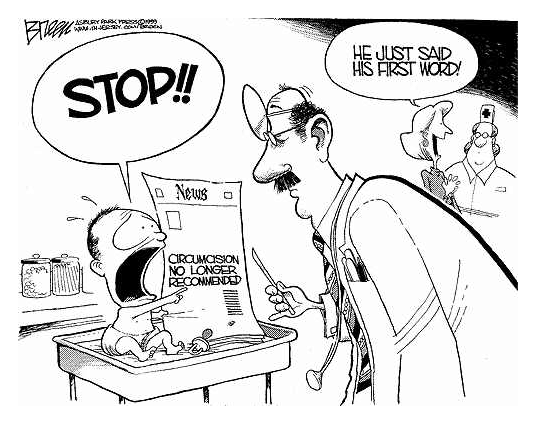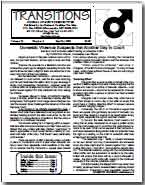 NCFM NOTE: Mr. Svoboda is one of the world’s leading anti-circumcision experts and advocates. He is a Human Rights Attorney and President of Attorneys for the Rights of Children. You can follow his work more closely at the ARC website.
NCFM NOTE: Mr. Svoboda is one of the world’s leading anti-circumcision experts and advocates. He is a Human Rights Attorney and President of Attorneys for the Rights of Children. You can follow his work more closely at the ARC website.
Neonatal Circumcision Violates Children’s Rights, Needlessly Amputating Functional Tissue
The long awaited circumcision policy statement from the American Academy of Pediatrics (AAP) may be most notable for what it does not address. The statement steadfastly omits any analysis of the foreskin, its erogenous, protective, and immunological functions, or crucially, the impact its removal has on normal sexual functioning and on the health and quality of life.
The AAP’s Task Force on Circumcision ignores a child’s well-established human and legal rights to decide for himself at an age of understanding whether he wants to part with his foreskin. Instead, the Committee says—with more honesty than ethics–that the common reluctance of an older child or adult to be circumcised justifies parents forcing a partial penile amputation upon him at an age when he is too small to effectively resist.
Male circumcision violates a child’s right to bodily integrity, not to mention numerous civil and criminal laws. Malpractice awards are mounting up, including a recent $700,000 settlement reported in the Massachusetts Lawyers Weekly. The AAP’s repeated suggestion that, “In most situations, parents are granted wide latitude in terms of the decisions they make on behalf of their children” badly misstates the law. In fact, starting in 1944 with Prince v. Massachusetts, courts have repeatedly affirmed that: “Parents may be free to become martyrs themselves. But it does not follow they are free, in identical circumstances, to make martyrs of their children before they have reached the age of full and legal discretion when they can make that choice for themselves.”[1]
Additionally, and perhaps even more egregiously, the AAP’s policy statement contradicts its own bioethics policy statement, which affirms that parental wishes cannot justify unnecessary surgery and that “providers have legal and ethical duties to their child patients to render competent medical care based on what the patient needs, not what someone else expresses.” Moreover, according to this same bioethics policy statement, a “pediatrician’s responsibilities to his or her patient exist independent of parental desires or proxy consent.” [2]
One puzzling aspect of the AAP policy statement is a contradictory dance performed on the question of how strong the alleged benefits of the procedure are. On the one hand, there is no recommendation for universal neonatal circumcision, and it is admitted—as it previously stated in its 1999 policy statement–that the “health benefits are not great enough to recommend routine circumcision of all male newborns.” Moreover, nowhere are the benefits and risks numerically compared, and the AAP repeatedly states that complication data is unknown. How then can it rationally conclude that, “Evaluation of current evidence indicates that the health benefits of newborn male circumcision outweigh the risks…?” And how can pediatricians be tasked by the AAP to “assist parents by explaining in a nonbiased manner, the potential benefits and risks…” despite the fact that the AAP says the risks are unknown?
The US has both the highest rate of circumcision and the highest rates of HIV and AIDS in the industrialized world, so a claim that the first can prevent the other two doesn’t pass the smell test. The AAP admits as much by saying that “key studies to date have been performed in African populations with HIV burdens that are epidemiologically different from HIV in the United States.” Moreover, the African studies were closer to a lowest common denominator than a “gold standard,” suffering from numerous critical flaws including selection bias, randomization bias, experimenter bias, inadequate blinding, supportive bias, participant expectation bias, lack of placebo control, inadequate equipoise, attrition of subjects, failure to investigate non-sexual HIV transmission, lead time bias, and time-out discrepancy. Additionally, the “60%” figure refers to the relative risk and seems calculated to deliberately mislead; the absolute risk reduction is only a measly 1.3%. As the AAP itself concedes, given vast differences in health conditions and modes of transmission between the US and Africa, the results can hardly justify infant male circumcision in the United States. Babies don’t get HIV and AIDS from sexual contact.
In fact, not a single study has ever proven that circumcision has actually decreased any disease in the United States. Over a hundred boys die each year from this needless procedure, yet the AAP fails to attach much significance to the deaths stemming from the practice.[3] Rather than objectively evaluating all available evidence, the AAP selectively quotes and references highly contested and controversial studies to attempt to justify an entrenched yet outmoded cultural—not medical—practice.
We were surprised to witness the reappearance of disproven justifications for circumcision such as urinary tract infections (UTIs), penile cancer, and even syphilis. The AAP also ignores the showing by Chessare that even if claims about UTIs are valid, the complications from the procedure exceed the benefits in preventing UTIs.[4]
From there, matters become even more interesting and even less defensible. The AAP fancifully claims at several points, using slightly different language, “It is reasonable to take these non medical benefits and harms for an individual into consideration when making a decision about circumcision.” In fact, few things are less reasonable and more unprecedented than physicians making medical decisions based on non-medical factors and vagaries of their infant patients’ parents’ culture and religion as central to whether to do a procedure. It is ironic that harms are improperly mentioned here but not properly discussed elsewhere. The other procedures that get cultural validation when medical basis is lacking can be counted on the fingers of zero hands.
Moreover, a huge logical hole appears when the policy statement suggests that, “Parents should weigh the health benefits and risks in light of their own religious, cultural, and personal preferences, as the medical benefits alone may not outweigh these other considerations for individual families.” One cannot coherently argue that circumcision is elective and of variable value at the individual level yet terribly important in a larger public health context.
The AAP selects, sometimes out of context, bits of language that seems to lend its position support, and completely ignores contradictory data. Thus the policy statement cites a study that proves that male circumcision removes the most sensitive part of the penis, then proceeds to ignore that inconvenient truth.[5] The policy statement cites a study suggesting that circumcising men actually increases the HIV risk to heterosexual women and similarly ignores that uncongenial finding.[6] Another study is introduced as evidence for circumcision helping prevent HIV, yet the AAP omits to mention that it also demonstrates that intact males who wait at least ten minutes after intercourse before wiping have a much lower rate of contracting HIV than do circumcised men.[7] The policy statement cites a study showing that smoking and a narrow foreskin, not a normal one, contribute to penile cancer, yet the AAP ignores those findings as not supporting the circumcision juggernaut.[We question why the AAP is effectively recommending an unnecessary surgery at a time when the US faces a crisis in not being able to provide even necessary care for all our children. As was just demonstrated in a report by the Institute for Medicine, an astonishing $750 billion is wasted on health care each year in this country.[9] Recently it was estimated that close to $2 billion of that amount may arise from this unnecessary and harmful procedure.[10] In these days of rising medical costs and scarce resources, we simply cannot afford to continue to carry out such a harmful and outmoded practice.
Given the many virtues claimed for male circumcision by the AAP, one may be forgiven for wondering why European men are not falling down dead in the street and are even enjoying better health indicators than American men including in the areas the statement cites as improved after circumcision? Neonatal circumcision is a gross violation of children’s rights. It inevitably causes pain when performed on infants, amputating tissue having erogenous, protective, and immunological functions. The AAP should immediately retract its policy statement and replace it with a document reflecting such critical concerns as the functions of the lost tissue and the importance of respecting non-consenting children’s rights.
[1] 321 U.S. 158, 170 (1944).
[2] American Academy of Pediatrics Committee on Bioethics, “Policy Statement: Informed Consent, Parental Permission, and Assent in Pediatric Practice,” Pediatrics. 1995;95(2):314–317, 315. Reaffirmed May 2011.
[3] Bollinger D. “Lost boys: An estimate of U.S. circumcision-related infant deaths,” THYMOS: Journal of Boyhood Studies. 2010;4(1):78-90.
[4] Chessare JB. “Circumcision: Is the risk of urinary tract infection really the pivotal issue?,” Clinical Pediatrics. 1992;31(2):100-104
[5] Sorrells ML, Snyder JL, Reiss MD, et al. Fine-touch pressure thresholds in the adult penis. BJU Int. 2007;99(4):864–869.
[6] Wawer MJ, Makumbi F, Kigozi G, et al. Circumcision in HIV-infected men and its effect on HIV transmission to female partners in Rakai, Uganda: a randomised controlled trial. Lancet. 2009;374(9685):229–237.
[7] Gray RH, Kigozi G, Serwadda D, et al. The effects of male circumcision on female partners’ genital tract symptoms and vaginal infections in a randomized trial in Rakai, Uganda. Am J Obstet Gynecol. 2009;200(1):42.e1–e7.
[8] Daling JR, Madeleine MM, Johnson LG, et al. Penile cancer: importance of circumcision, human papillomavirus and smoking in in situ and invasive disease. Int J Cancer. 2005;116(4):606–616.
[9] Smith M, Saunders R, Stuckhardt L. Best Care at Lower Cost: The Path to Continuously Learning Health Care in America. Washington, DC: National Academy of Sciences; 2012.
[10] Bollinger D. “Cost of Circumcisions.” 2012. Available at: http://www.icgi.org/information/cost-of-circumcisions/



